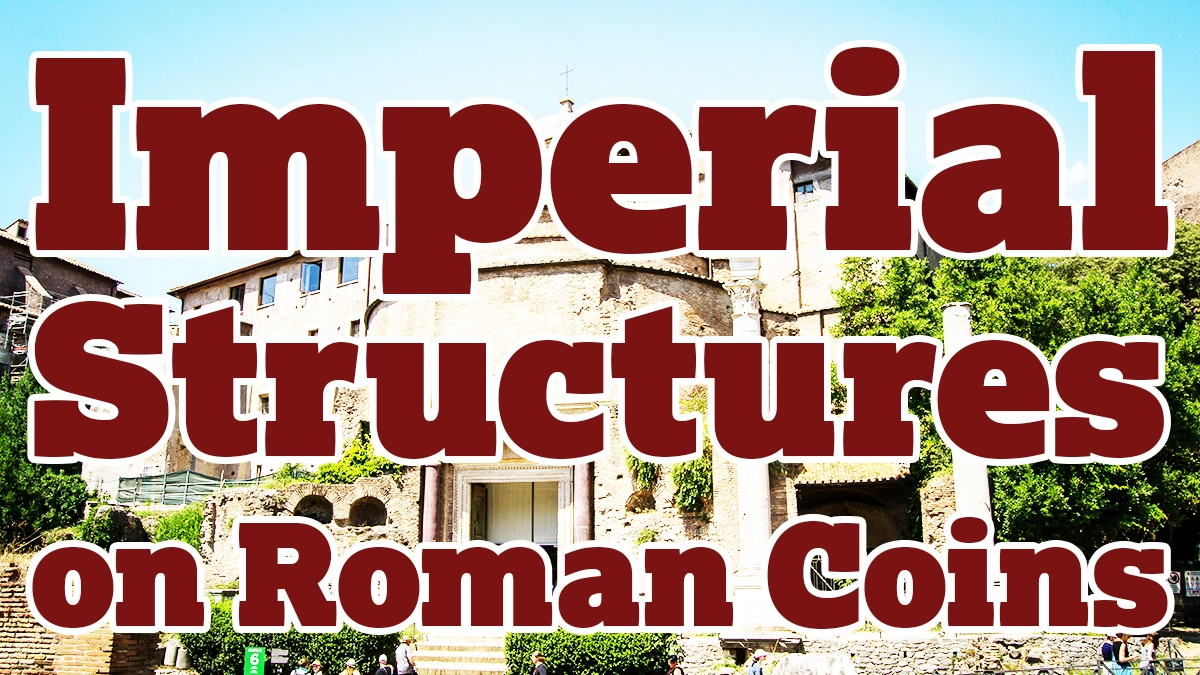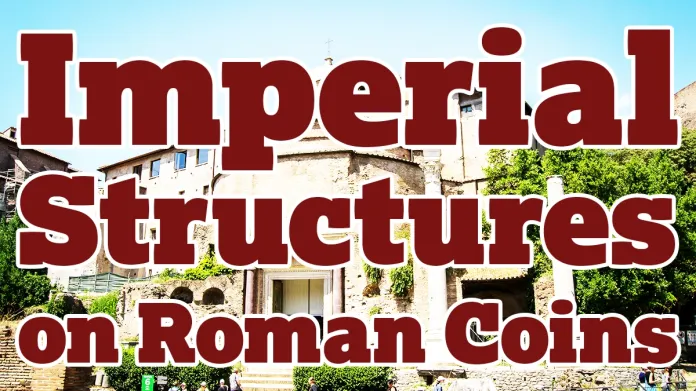
By Dr. Steve Benner for CoinWeek …..
Roman emperors (and their celators or celatores, the engravers who created the coin dies) liked to put monumental structures on their coinage, especially if they had them built themselves. A few refrained from putting structures on their coins at all (Tiberius, for example), but others used architectural designs quite frequently; do a search of “Antoninus Pius” and “temples” in one of the ancient coins listed databases below and I guarantee you’ll have plenty of hits. I myself have 10 coins with temple reverses, four of them featuring the Janus temple of Nero.
Unfortunately, the identities of many of the structures shown on these Roman coins are unknown. Descriptions in source documents often just say “hexastyle” (“six-columned”) or “octastyle” (“eight-columned”) temple, which doesn’t help since most no longer exist. It would be quite helpful to modern historians if these could be identified because there are many structures whose appearance is known only from coins. None of the structures in this article are still standing (except the Temple of Romulus and, to some extent, the nymphaeum of Severus Alexander), so the depictions are valuable information. For example, there were as many as 36 arches built in Rome – of which only three still exist. Let’s take a look at the coins.
Figure 1 is a map of ancient Rome numbered with the location of each of the structures covered by the coins I will discuss.
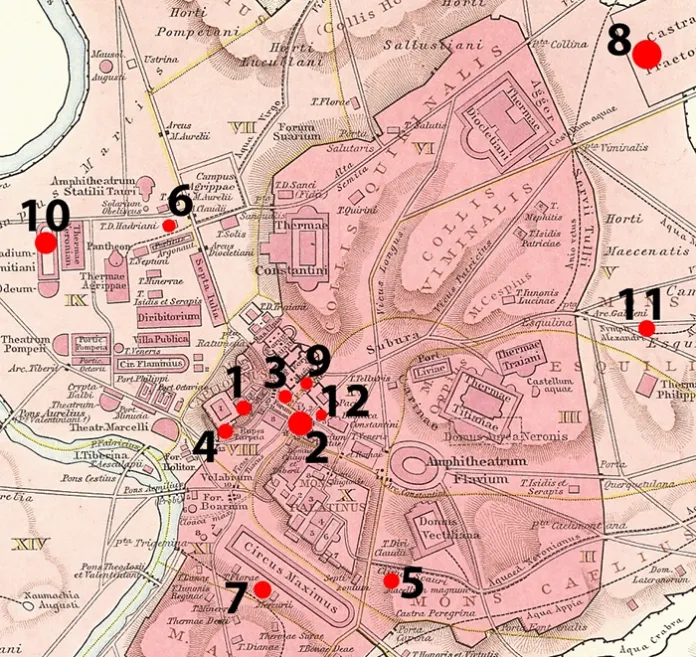
Coins of the Roman Republic (Locations 1-3)
The first denarius in this trio (Figure 2a) was originally minted by M.C. Marcellus in 50 BCE and has his profile on the obverse with a triskeles behind that reminds us of his conquest of Syracuse in 211 BCE during the Second Punic War (the triskeles is the symbol of Sicily and still appears on the Sicilian flag). This particular coin was reissued by the Emperor Trajan (98-117 BCE) in 107 or 1112/113 CE. The reverse of this denarius shows Marcellus carrying a Gallic trophy to the Temple of Jupiter Feretrius (“Jupiter of the Spoils”) on Capitoline Hill, which is located next to the Temple of Jupiter Optimus Maximus (“Jupiter the Best and Greatest”) location 1 in Figure 1). It symbolizes Marcellus’ victory in 222 BCE over the Celtic Insubres under their king Britomartus. The Temple of Jupiter Feretrius was the first temple built in Rome, the second being the one dedicated to Jupiter Optimus. Romulus, the founder and first legendary king of Rome, is said to have dedicated the temple in 752-751 BCE in appreciation for his victory over Acro, king of the Caeninenses.
The second denarius (Figure 2b) was issued by the moneyer P. Nerva in 113-112 BCE and has the helmeted head of Roma on the obverse. The reverse shows two citizens voting in the Comitium: one receiving his ballot from an attendant and another placing his ballot in the cista (“ballot box”). The Comitium was the central location for political and judicial activities in Rome and was located in the forum (location 2) between the Curia (Senate House) and the Rostra (speakers’ platform). It was a circular building where the Curiate Assembly met, and where religious festivals were held.
The third denarius (Figure 2c) was issued by L. Mussidius Longus in 42 BCE and depicts the bust of Concordia on the obverse, The reverse has a platform inscribed CLOACIN, on which there are two statues of Venus Cloacina. This Venus was the goddess of the Cloaca Maxima, the sewage drainage system of Rome. Her small circular shrine was located next to the Basilica Aemilia in the forum (location 3) above the Cloaca Maxima. The two deities on the platform may have represented two aspects of Cloacina-Venus (No. 1 and 2). “Cloacina”–from the verb cluere, meaning “to purify”–may also explain why she was called the “Cleanser” or “Purifier” since she was also credited with the purification of marital sex (I could make another joke here, but I would risk losing my PG rating). Later, the English used the term “going to the Temple of Cloacina” as an idiom meaning to go to the toilet.
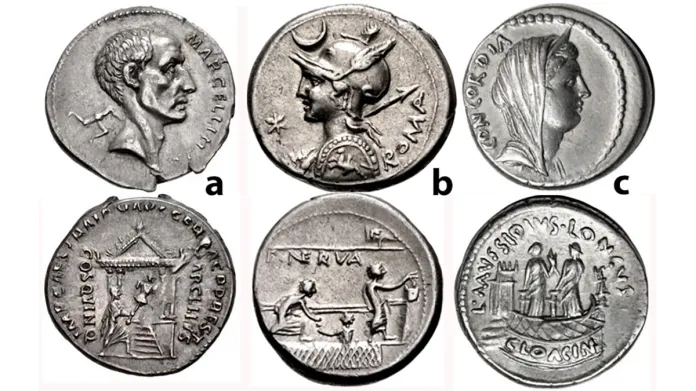
Coins of Augustus (Locations 2 and 4)
Figure 3 shows two denarii minted by the first Roman emperor, Augustus. Coin one shows Augustus on the obverse and a rostral column on the reverse (location 2 again). Along the sides, rostra (galleys’ ramming prows) were installed, and a statue of Augustus was placed on top. The term rostra (or rostrum, singular) came from the speaker’s platform in the Forum, located in front of the Comitium, which was decorated with the rostra from the Battle of Antium in 338 BCE. Augustus (still Octavian at the time) probably built this column to celebrate his victory at Actium in 31 BCE.
Coin two (Figure 3b) again shows Augustus on the obverse but features the Temple of Jupiter Tonans (“Jupiter the Thunderer”) on the reverse. Jupiter is shown standing inside the temple holding a scepter and a lightning bolt. This small hexastyle temple was built in 22 BCE by Augustus and played a major role in the Secular Games (Ludes Seculares), an artistic and religious festival that the emperor revived in 17 BCE. The temple (location 4) was located on Capitoline Hill next to the Temple of Jupiter Optimus Maximus. It was noted for the artwork that was displayed around it.
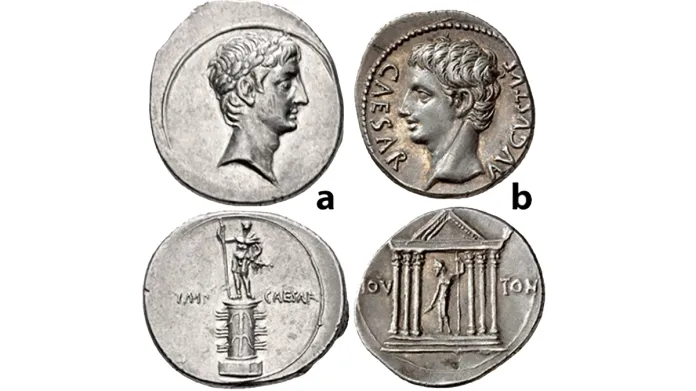
Roman Bronze and Orichalcum (Locations 5-7)
Figure 4 shows a dupondius and two sestertii with monumental architecture on their reverses. The first coin (Figure 4a) is a dupondius of Nero (ruled 54-68 CE) with his portrait on the obverse and the Macellum Magnum on the reverse. The Macellum was a Roman indoor market that sold mainly meat and fish but did sell other produce depending on local availability. It was located south of the Coliseum on the road connecting the Coliseum and the Circus Maximus (location 5). It contained a courtyard with a central tholos (a circular structure with a domed roof) surrounded by tabernae and shops all of equal size. Nero had the two-storied Macellum built in 59 CE. The one in Pompeii is a good extant example of a macellum.
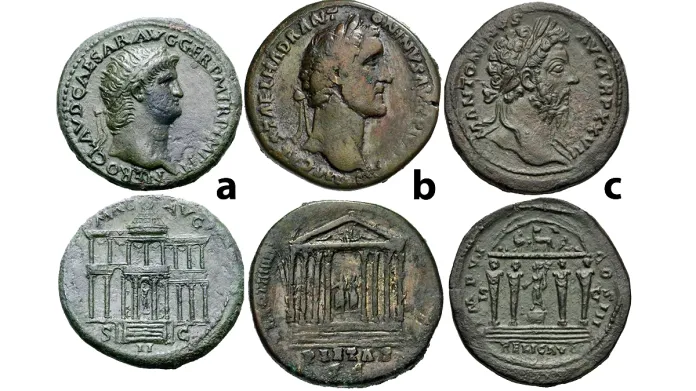
The second coin (Figure 4b) is a sestertius of Antoninus Pius (r. 138-161 CE), with his portrait on the obverse and the Hadrianeum on the reverse. This temple was dedicated to Hadrian and was built after his death by Antoninus, his adopted son (with some opposition from the Senate which didn’t like Hadrian very much). The Corinthian octastyle temple had a three-step base and statues of Hadrian and his wife Vibia Sabina inside. It was located in the Campus Martius (location 6) just west of Quirinal Hill. One cella wall (an inner chamber wall of a temple) and 11 columns from the external colonnade still survive and have been incorporated into the Carlo Fontana, now Rome’s Chamber of Commerce.
The third coin (Figure 4c) is a sestertius of Marcus Aurelius (r. 161-180 CE), with his portrait on the obverse and the Temple of Mercury on the reverse. The temple was founded in 495 BCE and was one of the oldest in Rome. It was a tetrastyle (“four-columned”) temple with Mercury standing on a pedestal inside, holding a caduceus and purse. It was located near the Circus Maximus (location 7); nothing remains of it today. Mercury was the popular Roman god of commerce, eloquence, travelers, communication, messengers, and trickery. The reverse legend RELIG(I0) AVG may indicate a special connection to the religious feeling of Aurelius. This coin and the prior sestertius are extremely rare coins.
Gold Roman Coins (Locations 8-11)
Figure 5 shows four aurei from four emperors, each highlighting different monuments. The first (Figure 5a) was minted by Claudius in 41/42 CE and has him on the obverse and the Praetorian Camp on the reverse. The Camp has IMPER RECEPT (“The Emperor Received”) on its front, which is meant to say that the emperor was presented to the Praetorian Guard, recognized as Emperor, and taken under their protection. Claudius was somewhat reluctantly made Emperor by the Praetorians after the murder of Caligula (r. 37-41 CE), so he had to suck up to them to stay in office. The Camp was built in 23 CE by Sejanus, Tiberius’ Praetorian Prefect. It was located outside the walls of Rome (location 8) and later destroyed by Constantine (r. 306-337), though some of the walls were incorporated into the Aurelian Wall and still stand.
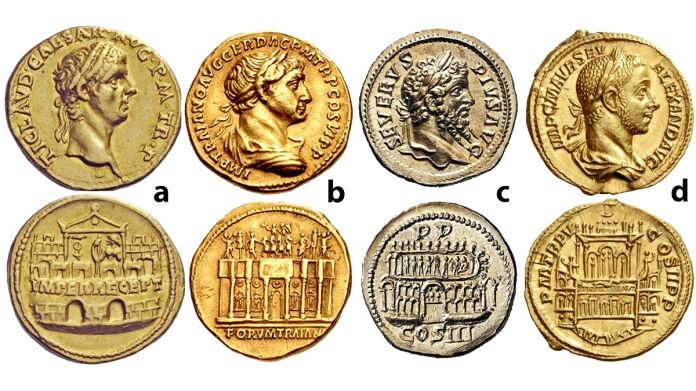
The second aureus (Figure 5b) was minted by Trajan in 112/113 CE and shows his Arcus Traiani, the triumphal entrance to the Forum Traiani (location 9). He was proud of the massive complex he had built just north of the Forum, using the money he appropriated from the Dacians. It included this entrance that looked more like a triumphal arch than an entryway, an equestrian statue of himself, a three-story market, the Basilica Ulpia, a Temple to the deified Trajan, two libraries, and his famous column.
Obviously, Trajan was not a worshipper of Pudicitia, goddess of modesty.
The next aureus (Figure 5c) is interesting in that the emperor on the obverse was not the one who built the stadium on the reverse. The coin was minted by Septimius Severus in 204 CE and has a reverse showing the Stadium of Domitian (r. 81-96 CE), built in 86 CE. Why Septimius decided to put it on his coin is not known, though perhaps he hoped that its popularity would rub off on him. The Stadium is now completely gone, but its outline is captured by the Piazza Navona, in which buildings incorporate the Stadium’s original lower arcades. This coin is extremely rare.
The last Roman coin is an aureus minted by Severus Alexander to show off his new Nymphaeum (Figure 5d). These were originally natural grottoes, which, tradition said, were the home of local water nymphs. Later, the Romans built artificial grottoes, usually as rotundas adorned with paintings and statues and topped with a dome or half dome. The exact date of its construction is unknown, though it was probably built before 226 CE when this coin was minted. It utilized water from the Aqua Julia aqueduct and was located between the Via Tiburtina and Via Labicana (location 11). Substantial parts of the Nymphaeum survive today–including the original foundation and water channels–and are a good source of information about Roman engineering methods.
Coins of Romulus (Location 12)
This last structure and coin are different from the others discussed here in that it was not built for a god but as a memorial to an emperor’s son. This Temple/Tomb was dedicated to the son of Maxentius (r. 306-312 CE), Romulus, who died in 309 CE. The follis in Figure 5 has Romulus on the obverse and the Temple on the reverse with the legend AETERNAE MEMORIAE. It was built in 310 CE of masonry and situated on the Via Sacra next to the Temple of Antoninus and Faustina (location 12). The Tomb is round, with a dome and eagle on top (symbol of the soul of the dead Romulus), and is still intact because it was converted into the vestibule for the Church of S. Cosma and S. Damiano in the sixth century (Figure 6). The Temple is depicted on coins with either no columns, four columns, or six columns. This was because there are two columns flanking the door and four to the right and left. Constantine the Great killed Maxentius at the Battle of Milvian Bridge in 312 CE and completed the construction of this temple and the Basilica of Maxentius. The coins were no longer minted after Maxentius’ death.
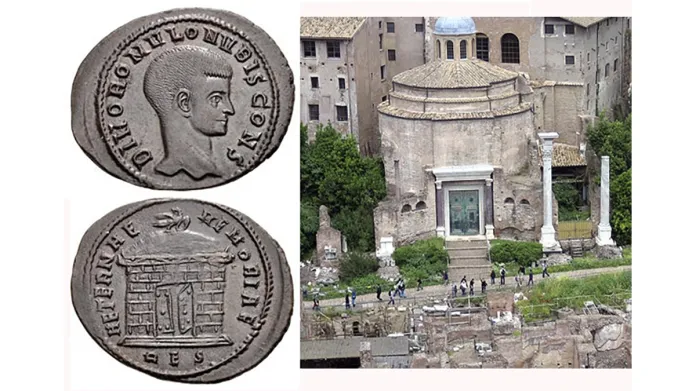
Comments
I think I have finally completed my numismatic survey of Roman structures on coins, which is unfortunate since I enjoy writing about them. It is educational to me since I had never heard of some of these coins, like the Nymphaeum (I’ll have to take a look at it next time I’m in Rome). Plus, when I visited the Temple of Romulus, I incorrectly thought it was dedicated to the founder of Rome. Most of the coins in this article are not common and, as a result, can be very expensive; the follis is not.
* * *
References for Imperial Structures on Roman Coins
https://www.wildwinds.com/coins/
Boardman, John, Jasper Griffin, and Oswyn Murray. The Oxford History of the Classical World. Oxford University Press: New York, London (1993).
Hornblower, Simon, Spawforth, Antony (ed.). The Oxford Classical Dictionary. Oxford (1996).
Madden, F., C.R Smith, and S.W. Stevenson. A Dictionary of Roman Coins. London (1889).
Ortega, Ivan Fumado. “Triumphal Arches”, National Geographic. (Jan/Feb 2025).
Sutherland, CHV, and RAG Carson. The Roman Imperial Coinage. Spink and Son: London (various).
Tameanko, Marvin. Monumental Coins. Krause Publications: St. Iola, WI (1999).
* * *


